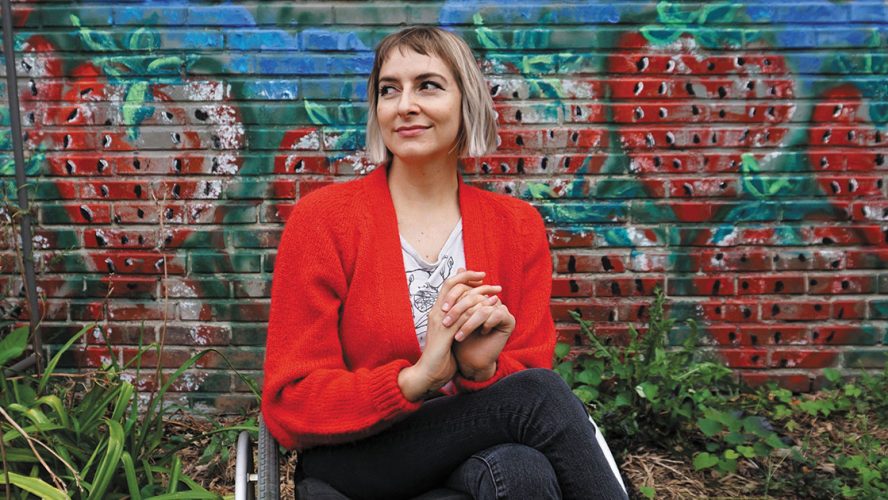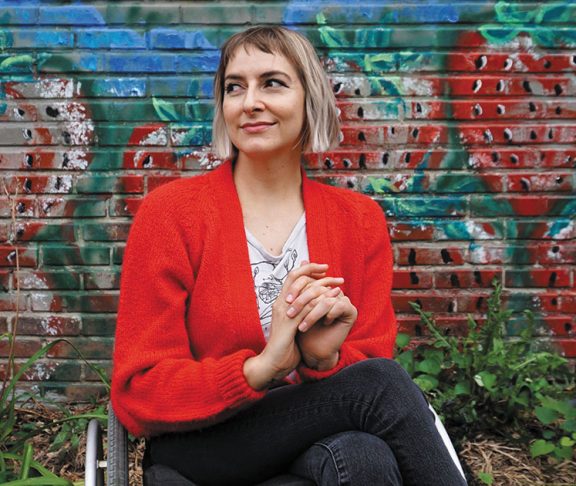Rebekah Taussig, Instagram influencer and advocate, has had a very big year. In addition to having her life upended by the pandemic, Taussig also helped her husband deal with his cancer diagnosis, published her first book, and gave birth to her first child.
Taussig says this year has been as exhausting as you probably imagine, but it also fits pretty perfectly with her life ethos. Taussig’s writing is an inward reflection on her own life, as well as a representative voice for other people with disabilities. But, she says, it also shows how some experiences are universal. After all, we all have bodies.
Finding representation
Taussig, who uses a wheelchair, has built a devoted Instagram following, both among the disabled and abled communities. She posts beautiful photographs of her disabled body along with her thoughtful commentary in the captions.
“Five years ago, I started unpacking a lot of what it means to be disabled,” she said. “I lived in this disabled body for most of my life, but had not really thought very critically about what that meant for me, and how that shaped me, and how that might be a part of my identity.”
Taussig says she didn’t have a disabled community in her own life, so she started posting on Instagram and building one of her own.
It was hard for Taussig to find beautiful imagery of people in wheelchairs or of disabled people outside of a medical context while growing up. Going through some old photos of her own, she found that she had tried to cover up her disability.
“I noticed I was cropping my wheelchair out of all of the pictures, so kind of erasing that part of me visually, and I think kind of in an attempt to distance myself from that as a part of me,” she said. “Part of the draw of Instagram, in addition to processing what disability means to me, was just gathering beautiful images that included disability.”
She says her book, titled “Sitting Pretty: The View From My Ordinary Resilient Disabled Body,” was a way to expand and dig deeper into the content she posted to her Instagram.
“A lot of what I write about is disability-specific,” Taussig said. “But it’s also like, what is it like to have a body at all? And since we all have bodies, I think there are a lot of universal points of connection there. And there were non-disabled people who were just wanting to understand the experience.”
Learning to be a parent
One unexamined aspect of the experience of disability is pregnancy and parenthood. Taussig says it was extremely hard to find any helpful information online, and she thinks people aren’t used to thinking of disabled people as caregivers rather than caretakers.
“There are not representations of disabled parents to look to both in a practical sense, like how am I gonna carry my baby around, you know, or lifting out of this bed, but also in an empowering, validating sort of way,” she said. “Like you have permission to be a parent, like we as a culture agree that this is a valid role for you to play.”
She says she’s found other Instagram communities that have been sources of help and comfort, and adds that she’s grateful for the helpful medical treatment she received.
However, reactions to her becoming a mom have not always been supportive.
“There are people who will push against disabled people being parents,” Taussig said, “like in a very scary, take-your-children-away sort of way.”
She also notes that while there are no laws that prohibit disabled parents from adopting children, it is much more difficult.
Taussig says just like any other first-time parent, she’s jumping into the unknown.
Taking turns
It also isn’t the first time she’s had the role of caretaker. When her husband was diagnosed with cancer, she says the two of them learned to work together to care for one another.
“I don’t know how much of this was coincidence, and how much of it was the intuition of our individual bodies or what, but we really took turns in the last nine months,” Taussig said. “When one of us was feeling better, the other person seemed to take a turn for the worse and vice versa.”
She says alternating between caretaker and caregiver also helped the couple grow as a team, and prepared them for the teamwork of parenting a newborn.
“We are building this partnership that is kind of fortified from all sides,” Taussig said. “I think that that has really prepared us for parenting (our son) Otto together, because we are 100 percent a team in the way that we parent him in a way that feels really good.”
A chance for growth
The pandemic has changed the way we, as a society, do everything from working to parenting. And now that everyone who can is working from home, Taussig hopes the experience will help people understand the importance of flexible working conditions for all bodies.
“It’s frustrating to see how willing people are to scramble to make those accommodations in one context but not be able to to have them in the other context that allows disabled people to participate,” she said. “The idealistic part of me hopes that experience continues. My hope is that at the very least people have a more concrete understanding now of why people in different bodies might need to make exceptions.”
As everyone says, we’re all in this together. Hopefully the pandemic, with Taussig’s help, also teaches how having a body is both a unique and a universal experience.

